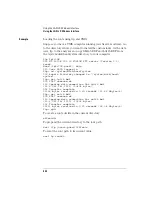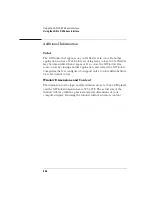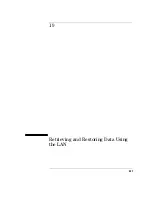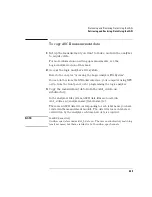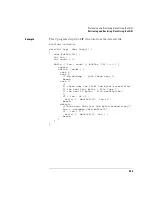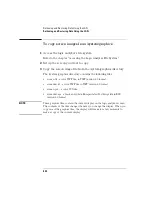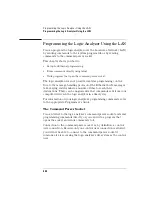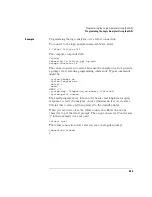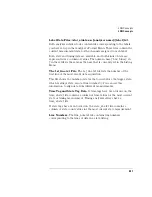
537
Retrieving and Restoring Data Using the LAN
Retrieving and Restoring Data Using the LAN
To copy configurations from setup.raw
1
Set up the configuration.
You can do this from the XWindow interface or from the front panel.
2
Access the logic analyzer’s file system.
Refer to the chapter "Accessing the Logic Analyzer File System".
3
Copy the setup.raw file from the appropriate directory.
For system configurations, the appropriate directory is \system . For
analyzer configurations, the appropriate directory is \slot_a . For
oscilloscope configurations, the appropriate directory is \slot_b .
Raw configuration files are binary format files that can be transferred
to your computer and then reloaded into the logic analyzer later. Raw
configuration files are not transferable between logic analyzer models.
The setup.raw file is overwritten whenever you change the
configuration.
Dynamic Configuration Files
Configuration files are dynamic files. When you look at the logic
analyzer file system, dynamic files show a file size of 1 or 0. 0 means
there isn’t anything available and 1 means there is. When you request
the dynamic file, the logic analyzer creates it. While the analyzer is
creating the file, it will not respond to other requests. Because the
analyzer does not know the file size until it is created, some NFS
systems have trouble copying dynamic files. If the cp command does
not appear to work, try using dd.
Summary of Contents for 1670E Series
Page 6: ...6 In This Book...
Page 26: ...26 Contents...
Page 27: ...27 Section 1 Logic Analyzer...
Page 28: ...28...
Page 29: ...29 1 Logic Analyzer Overview...
Page 39: ...39 2 Connecting Peripherals...
Page 49: ...49 3 Using the Logic Analyzer...
Page 72: ...72 Using the Logic Analyzer The Inverse Assembler...
Page 73: ...73 4 Using the Trigger Menu...
Page 101: ...101 5 Using the Oscilloscope...
Page 151: ...151 6 Using the Pattern Generator...
Page 199: ...199 7 Triggering Examples...
Page 237: ...237 8 File Management...
Page 249: ...249 9 Logic Analyzer Reference...
Page 360: ...360 Logic Analyzer Reference The Compare Menu...
Page 361: ...361 10 System Performance Analysis SPA Software...
Page 397: ...397 11 Logic Analyzer Concepts...
Page 430: ...430 Logic Analyzer Concepts The Analyzer Hardware Oscilloscope board theory Oscilloscope board...
Page 439: ...439 12 Troubleshooting the Logic Analyzer...
Page 455: ...455 13 Specifications...
Page 471: ...471 14 Operator s Service...
Page 479: ...479 Operator s Service Troubleshooting Troubleshooting Flowchart 2...
Page 491: ...491 Section 2 LAN...
Page 492: ...492...
Page 493: ...493 15 Introducing the LAN Interface...
Page 497: ...497 16 Connecting and Configuring the LAN...
Page 506: ...506 Connecting and Configuring the LAN Connecting and Configuring the LAN...
Page 507: ...507 17 Accessing the Logic Analyzer File System Using the LAN...
Page 515: ...515 18 Using the LAN s X Window Interface...
Page 527: ...527 19 Retrieving and Restoring Data Using the LAN...
Page 539: ...539 20 Programming the Logic Analyzer Using the LAN...
Page 546: ...546 Programming the Logic Analyzer Using the LAN Programming the Logic Analyzer Using the LAN...
Page 547: ...547 21 LAN Concepts...
Page 555: ...555 22 Troubleshooting the LAN Connection...
Page 580: ...580 Troubleshooting the LAN Connection Getting Service Support...
Page 581: ...581 Section 3 Symbol Utility...
Page 582: ...582...
Page 583: ...583 23 Symbol Utility Introduction...
Page 588: ...588 Symbol Utility Introduction Symbol Utility Introduction...
Page 589: ...589 24 Getting Started with the Symbol Utility...
Page 597: ...597 25 Using the Symbol Utility...
Page 609: ...609 26 Symbol Utility Features and Functions...


